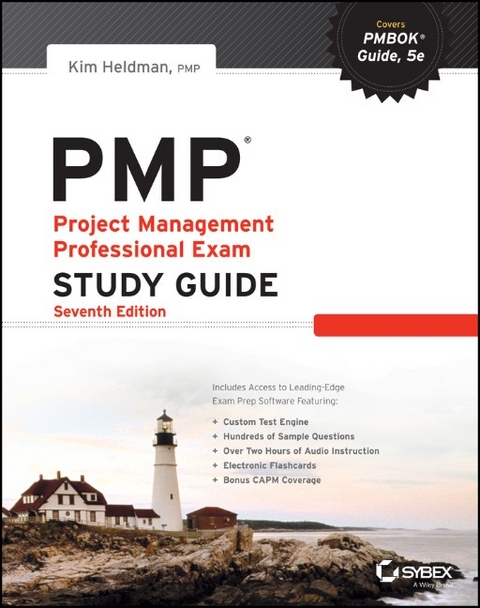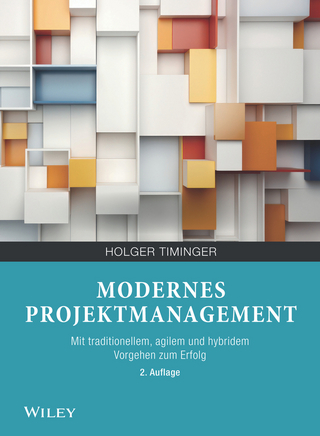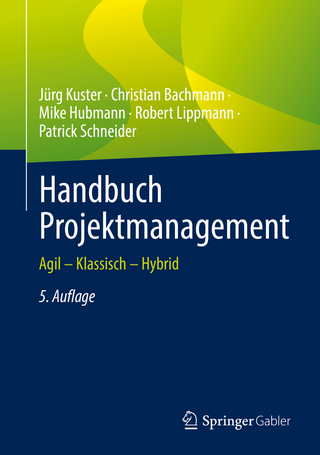
Pmp
John Wiley & Sons Inc (Verlag)
978-1-118-53182-2 (ISBN)
- Titel ist leider vergriffen;
keine Neuauflage - Artikel merken
The ultimate package for preparing you to take the PMP exam Project management is one of the most desired skills in today's IT marketplace and the Project Management Professional (PMP) exam reflects your level of proficiency and preparedness as a project manager. This comprehensive study guide features the Sybex test engine with two practice PMP exams, electronic flashcards, two hours of audio review, as well as two bonus Certified Associate in Project Management (CAPM) exams. The book covers a wide-range of project management and exam topics, concepts, and key terms. Not only does this must-have resource reflect the very latest version of the exam, it is written by popular project management expert Kim Heldman, who is the author of the six previous editions of this top-selling book.
* Prepares you to take the Project Management Professional (PMP) exam as well as the Certified Associate in Project Management (CAPM) exam, both offered by the Project Management Institute (PMI) * Covers all exam topic areas plus a wide range of project management processes, concepts, and key terms * Uses real-world scenarios and How This Applies to Your Current Project sidebars to fully illustrate concepts * Readers get access to invaluable study tools with testing software, practice exams, electronic flashcards, and over two hours of audio review PMP: Project Management Professional Exam Study Guide, Seventh Edition helps you prepare for the PMP exam and also serves as an essential resource for becoming a more astute project manager.
Kim Heldman, PMP, is a Business Relationship Manager for the Regional Transportation District in Denver, Colorado. She has over 20 years of experience in project management and consulting. Kim is the author of several books on project management, including Project Management JumpStart and the six previous editions of the bestselling PMP: Project Management Professional Exam Study Guide. You can visit her website at www.kimheldman.com.
Introduction xxv Assessment Test xxxvi Chapter 1 What Is a Project? 1 Is It a Project? 2 Projects versus Operations 3 Stakeholders 5 Project Characteristics 7 What Is Project Management? 7 Programs 8 Portfolios 9 Project Management Offices 10 Skills Every Good Project Manager Needs 12 Communication Skills 13 Organizational and Planning Skills 13 Conflict Management Skills 14 Negotiation and Influencing Skills 14 Leadership Skills 15 Team-Building and Motivating Skills 15 Role of a Project Manager 16 Understanding Organizational Structures 16 Functional Organizations 17 Projectized Organizations 20 Matrix Organizations 22 Project-Based Organizations 26 Understanding Project Life Cycles and Project Management Processes 26 Project Phases and Project Life Cycles 27 Project Management Process Groups 30 Understanding How This Applies to Your Next Project 36 Summary 36 Exam Essentials 37 Key Terms 39 Review Questions 40 Chapter 2 Creating the Project Charter 45 Exploring the Project Management Knowledge Areas 47 Project Integration Management 49 Project Scope Management 50 Project Time Management 51 Project Cost Management 51 Project Quality Management 52 Project Human Resource Management 53 Project Communications Management 54 Project Risk Management 55 Project Procurement Management 55 Project Stakeholder Management 56 Understanding How Projects Come About 56 Needs and Demands 57 Feasibility Studies 59 Performing Project Selection and Assessment 60 Using Project Selection Methods 62 Kicking Off the Project Charter 70 Project Statement of Work 71 Business Case 72 Agreements 73 Enterprise Environmental Factors 73 Organizational Process Assets 74 Tools and Techniques 75 Formalizing and Publishing the Project Charter 76 Pulling the Project Charter Together 76 Key Stakeholders 77 Project Charter Sign-Off 79 Identifying Stakeholders 79 Identify Stakeholders Inputs 79 Stakeholder Analysis 80 Stakeholder Register and Strategy 83 Introducing the Kitchen Heaven Project Case Study 83 Understanding How This Applies to Your Next Project 87 Summary 88 Exam Essentials 89 Key Terms 91 Review Questions 92 Chapter 3 Developing the Project Scope Statement 97 Developing the Project Management Plan 99 Developing Inputs 99 Documenting the Project Management Plan 101 Plan Scope Management 104 Understanding the Plan Scope Management Inputs 105 Using Plan Scope Management Tools and Techniques 106 Documenting the Scope Management Plan 106 Documenting the Requirements Management Plan 107 Collecting Requirements 108 Using the Tools and Techniques of the Collect Requirements Process 110 Documenting Requirements 112 Defining Scope 115 Product Analysis 116 Alternatives Generation 117 Writing the Project Scope Statement 118 Understanding the Scope Statement Components 118 Approving and Publishing the Project Scope Statement 125 Updating the Project Documents 125 Creating the Work Breakdown Structure 127 Gathering the WBS Inputs 128 Decomposing the Deliverables 128 Constructing the WBS 129 Creating WBS Process Outputs 137 Understanding How This Applies to Your Next Project 141 Summary 143 Exam Essentials 144 Key Terms 145 Review Questions 146 Chapter 4 Creating the Project Schedule 153 Creating the Schedule Management Plan 154 Defining Activities 155 Define Activities Process Inputs 156 Tools and Techniques for Defining Activities 156 Define Activities Outputs 157 Understanding the Sequence Activities Process 158 Sequence Activities Tools and Techniques 159 Sequence Activities Outputs 164 Estimating Activity Resources 164 Estimate Activity Resources Inputs 165 Estimate Activity Resources Tools and Techniques 166 Estimate Activity Resources Outputs 167 Estimating Activity Durations 167 Estimate Activity Durations Inputs 168 Estimate Activity Durations Tools and Techniques 168 Estimate Activity Durations Outputs 172 Developing the Project Schedule 173 Develop Schedule Inputs 174 Develop Schedule Tools and Techniques 175 Scheduling Process Outputs 188 Understanding How This Applies to Your Next Project 196 Summary 197 Exam Essentials 198 Key Terms 200 Review Questions 202 Chapter 5 Developing the Project Budget and Communicating the Plan 207 Creating the Project Cost Management Plan 208 Performing Plan Cost Management 209 Creating the Cost Management Plan 209 Estimating Costs 211 Estimate Costs Inputs 211 Tools and Techniques to Estimate Costs 214 Estimate Costs Process Outputs 216 Establishing the Cost Baseline 217 Determine Budget Inputs 218 Determine Budget Tools and Techniques 219 Determine Budget Process Outputs 220 Understanding Stakeholders 223 Analyzing Stakeholders 224 Stakeholder Management Plan 225 Communicating the Plan 225 Plan Communications Management Inputs 226 Tools and Techniques for Plan Communications Management 227 Plan Communications Management Outputs 231 Understanding How This Applies to Your Next Project 235 Summary 235 Exam Essentials 236 Key Terms 238 Review Questions 239 Chapter 6 Risk Planning 245 Planning for Risks 246 Planning Your Risk Management 247 Plan Risk Management Inputs 248 Tools and Techniques for Plan Risk Management 249 Creating the Risk Management Plan 250 Identifying Potential Risk 255 Identify Risks Inputs 256 Tools and Techniques for Identify Risks 258 Identify Risks Outputs 264 Analyzing Risks Using Qualitative Techniques 265 Perform Qualitative Risk Analysis Inputs 266 Tools and Techniques for Perform Qualitative Risk Analysis 266 Ranking Risks in the Risk Register 273 Quantifying Risk 274 Tools and Techniques for Perform Quantitative Risk Analysis 275 Perform Quantitative Risk Analysis Outputs 279 Developing a Risk Response Plan 280 Tools and Techniques for Plan Risk Responses 281 Plan Risk Responses Outputs 285 Understanding How This Applies to Your Next Project 290 Summary 291 Exam Essentials 292 Key Terms 293 Review Questions 294 Chapter 7 Planning Project Resources 299 Procurement Planning 300 Plan Procurement Management Inputs 301 Tools and Techniques for Plan Procurement Management 303 Plan Procurement Management Outputs 308 Developing the Human Resource Management Plan 313 Plan Human Resource Management Inputs 313 Plan Human Resource Management Tools and Techniques 316 Plan Human Resource Management Outputs 318 Quality Planning 321 Plan Quality Management Inputs 321 Tools and Techniques for Plan Quality Management 323 Plan Quality Management Outputs 331 Bringing It All Together 334 Understanding How This Applies to Your Next Project 338 Summary 339 Exam Essentials 340 Key Terms 342 Review Questions 344 Chapter 8 Developing the Project Team 349 Directing and Managing Project Work 350 Executing Inputs 352 Tools and Techniques of Direct and Manage Project Work 353 Outputs of Direct and Manage Project Work 353 Acquiring the Project Team 357 Tools and Techniques of Acquire Project Team 358 Outputs of Acquire Project Team 359 Developing the Project Team 361 Tools and Techniques of Develop Project Team 362 Outputs of Develop Project Team 377 Managing Project Teams 378 Tools and Techniques for Managing Teams 378 Managing Project Team Outputs 383 Understanding How This Applies to Your Next Project 386 Summary 387 Exam Essentials 388 Key Terms 389 Review Questions 390 Chapter 9 Conducting Procurements and Sharing Information 395 Conducting Procurements 396 Conduct Procurements Tools and Techniques 397 Conduct Procurements Outputs 403 Laying Out Quality Assurance Procedures 406 Inputs to Perform Quality Assurance 406 Perform Quality Assurance Tools and Techniques 407 Perform Quality Assurance Outputs 409 Managing Project Information 410 Tools and Techniques of Manage Communications 411 Output of Manage Communications 415 Managing Stakeholder Engagement 417 Manage Stakeholder Engagement Inputs 417 Tools and Techniques for Manage Stakeholder Engagement 418 Manage Stakeholder Engagement Outputs 418 Understanding How This Applies to Your Next Project 422 Summary 423 Exam Essentials 423 Key Terms 425 Review Questions 426 Chapter 10 Measuring and Controlling Project Performance 433 Monitoring and Controlling Project Work 436 Monitor and Control Project Work Inputs 437 Monitor and Control Project Work Outputs 439 Controlling Procurements 441 Controlling Procurements Inputs 442 Controlling Procurements Tools and Techniques 443 Managing Control Procurements Outputs 445 Controlling Communications 448 Control Communications Inputs 449 Control Communications Tools and Techniques 449 Control Communications Outputs 451 Managing Perform Integrated Change Control 453 How Change Occurs 454 Change Control Concerns 455 Configuration Control 456 Change Control System 457 Perform Integrated Change Control Inputs, Tools and Techniques, and Outputs 460 Controlling Stakeholder Engagement 462 Understanding How This Applies to Your Next Project 465 Summary 466 Exam Essentials 466 Key Terms 468 Review Questions 469 Chapter 11 Controlling Work Results 475 Monitoring and Controlling Risk 476 Control Risks Inputs 477 Control Risks Tools and Techniques 478 Control Risks Outputs 479 Managing Cost Changes 480 Control Costs Inputs 480 Control Costs Tools and Techniques 481 Control Costs Outputs 492 Monitoring and Controlling Schedule Changes 495 Control Schedule Inputs 495 Control Schedule Tools and Techniques 496 Control Schedule Outputs 497 Utilizing Control Quality Techniques 498 Control Quality Inputs 499 Control Quality Tools and Techniques 499 Control Quality Outputs 507 Validating Project Scope 508 Controlling Scope 509 Control Scope Inputs 510 Control Scope Tools and Techniques 510 Control Scope Outputs 510 Understanding How This Applies to Your Next Project 513 Summary 515 Exam Essentials 515 Key Terms 517 Review Questions 518 Chapter 12 Closing the Project and Applying Professional Responsibility 523 Formulating Project Closeout 524 Characteristics of Closing 525 Project Endings 525 Closing Out the Project 528 Administrative Closure Procedures 529 Close Project or Phase Inputs 530 Close Project or Phase Tools and Techniques 530 Close Project or Phase Outputs 531 Closing Out the Procurements 534 Close Procurements Inputs 535 Close Procurements Tools and Techniques 535 Close Procurements Outputs 535 Celebrate! 537 Releasing Project Team Members 537 Balancing Stakeholders Interests at Project Close 537 Competing Needs 538 Dealing with Issues and Problems 538 Balancing Constraints 539 Professional Responsibility 541 Responsibility 541 Respect 544 Fairness 547 Honesty 550 Role Delineation Study 552 Applying Professional Knowledge 552 Project Management Knowledge 552 Education Providers 553 Industry Knowledge 553 Understanding How This Applies to Your Next Project 557 Summary 558 Exam Essentials 560 Key Terms 561 Review Questions 562 Appendix A Answers to Review Questions 569 Chapter 1: What Is a Project? 570 Chapter 2: Creating the Project Charter 571 Chapter 3: Developing the Project Scope Statement 572 Chapter 4: Creating the Project Schedule 574 Chapter 5: Developing the Project Budget and Communicating the Plan 576 Chapter 6: Risk Planning 577 Chapter 7: Planning Project Resources 579 Chapter 8: Developing the Project Team 580 Chapter 9: Conducting Procurements and Sharing Information 582 Chapter 10: Measuring and Controlling Project Performance 583 Chapter 11: Controlling Work Results 585 Chapter 12: Closing the Project and Applying Professional Responsibility 586 Appendix B Process Inputs and Outputs 589 Initiating Processes 590 Planning Processes 591 Executing Processes 601 Monitoring and Controlling Processes 604 Closing Processes 609 Appendix C About the Additional Study Tools 611 Additional Study Tools 612 Sybex Test Engine 612 Electronic Flashcards 612 PDF of Glossary of Terms 612 Adobe Reader 612 Audio Files 613 System Requirements 613 Using the Study Tools 613 Troubleshooting 613 Customer Care 614 Index 615
| Verlagsort | New York |
|---|---|
| Sprache | englisch |
| Maße | 191 x 234 mm |
| Gewicht | 1 g |
| Themenwelt | Mathematik / Informatik ► Informatik |
| Sozialwissenschaften ► Pädagogik | |
| Wirtschaft ► Betriebswirtschaft / Management ► Projektmanagement | |
| ISBN-10 | 1-118-53182-5 / 1118531825 |
| ISBN-13 | 978-1-118-53182-2 / 9781118531822 |
| Zustand | Neuware |
| Informationen gemäß Produktsicherheitsverordnung (GPSR) | |
| Haben Sie eine Frage zum Produkt? |
aus dem Bereich


